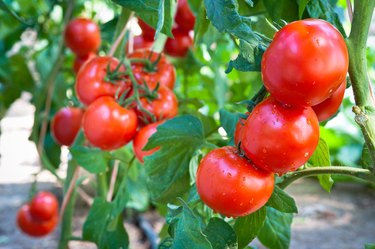
When you decide to grow tomatoes, you may have concerns like how to keep birds from eating your tomato plants. Birds protect tomato plants (Solanum lycopersicum, USDA zones 10-11) by eating insects, such as hornworms and snails, that harm the plants. If, however, the birds nibble on the plants' ripening fruits, then they can quickly become a gardener's worst enemy.
Finding the most effective way to defend your tomato fruits from birds is an ongoing process of trial and error. Help the fruits reach their maximum potential by combining a variety of measures to keep birds at bay.
Video of the Day
Video of the Day
Identifying Bird Tomato Plant Damage
Birds, rats, cats, squirrels and opossums often nosh on tomato fruits, and using a slightly different deterrent for each animal is necessary to protect the plants. Before you try to figure out how to keep birds from eating your tomato plants, determine whether or not a bird is the culprit for tomato fruit damage.
Check the fruits' skin for individual puncture marks resembling a bird's beak. Bird damage is most easily identified on fruits that have only a few small pecks on them, but it is also visible along the edges of damage on more severely attacked fruits. Tomato fruits attacked by other animals often have marks from incisor teeth.
Additionally, take note of the time of day the damage occurs. Although catching the culprit in the act of eating the fruits may not be possible, a bird is most likely responsible if the damage happens during daylight hours.
Protecting the Plants
Protecting tomato plants with bird netting keeps the fruits safe from being devoured by pesky birds. Create a framework around the plants by using bamboo poles, a wooden trellis, fence posts or tall stakes. The correct height for the framework depends on the potential height of the tomato plant variety grown, but the height should range from 3 to 8 feet tall. Drape bird netting loosely over the framework, and ensure it doesn't touch the plants. Secure the netting to the ground by using wire.
Be cautious when using netting. Although it inhibits a bird's ability to reach tomato fruits, it also restricts a bird's ability to reach and eat insects harmful to tomato plants. Careful, regular inspection of the tomato plants will help ensure damage from other pests does not occur.
Scaring Away Birds
Moving objects can help scare away birds before they reach your tomato plants. Garden pinwheels add a decorative touch and move with the wind to scare off birds. You can also use fishing line to hang shiny objects, such as aluminum pie pans or old DVDs, that reflect light and scare birds. If you hang multiple objects close together, the sound of them banging is another deterrent.
Providing Birds With Alternatives
Birds peck tomato fruits to quench their thirst, not necessarily because of hunger. A water feature, such as a water-filled birdbath set in a location safe from outdoor predators, can help birds eliminate their search for hydration in garden-grown fruits and vegetables. Additionally, planting species with sweet fruits near the birdbath can satisfy birds' appetites for sweet fare and distract them from maturing fruits on tomato plants. Plants with sweet fruits include figs (Ficus carica), hardy in USDA zones 7 through 10.
Picking Tomatoes When They're Pink
As tomato fruits grow, they require warm temperatures, and not necessarily sunlight, to ripen fully. So before the fruits turn bright red, it's safe to pluck them from the plants. Pick the fruits just as they start to turn pink, and place them indoors out of direct sunlight to ripen. Because the fruits grow quickly and can ripen fast when fully grown, check the plants daily to avoid missing the ideal harvesting window.